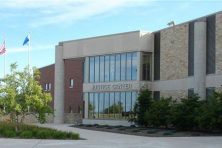County Passes 2023 Budget
- Share
- Tweet
- Pin
- Share

The County of Door passed its 2023 budget unanimously following a budget hearing Tuesday.
The tax levy raised from property owners will fund $30,691,035 of the $108,936,666 budget. The property-tax levy is 2.4% higher than the 2022 tax levy, the maximum allowed under the state levy cap that uses net new construction as a baseline (the county’s net new construction grew 1.511%).
The mill rate used to determine individual property taxes is lower for 2023, at 3.105 versus 3.564 this year. That 12.87% drop in the tax rate came about because of an unprecedented, 17.52% increase in the county’s equalized value – the value of all real estate and personal property in Door County – which grew from $8,556,994,600 to $10,079,363,600.
“If you have a home that did not change in value, you will experience a reduction in your county tax portion,” said Ken Pabich, Door County administrator.
For a home that’s assessed at $200,000, for example, the county portion of a tax bill would decrease by $91.80, from $712.80 this year to $621 in 2023.
Overall expenses are up $27,315,882 over 2022. Of that, general-fund expenditures are increasing 0.10%, from $27,986,098 to $35,312,359. Almost $2 million of that comes from salary increases (3%) and health-insurance increases (10%) for all employees, as well as additional positions previously approved by supervisors for Emergency Medical Services, the Sheriff’s Office, Health and Human Services and the Parks Department.
Capital projects designated for 2023 come to $22,772,742 – up $15,148,753 over 2022. Among those are a rural-addressing signage-replacement project ($1.2 million), airport improvements ($7.9 million), facilities and parks improvements ($7,275,758) and road work ($4,339,850).
“Usually, we try to do 17-18 miles a year,” Pabich said. “We’ll do 19.84 miles in 2023.”
The property-tax levy funds $30,691,035 of the budget. Investment income, state and federal aid, and charges for county services make up the remaining $78,245,631 in revenue to fund the budget.
The county sales tax – 0.5% charged on certain goods and services – has also become a significant source of county income, increasing by record amounts over the past couple of years. In 2021, the county collected $5,633,974 – up from $4,434,050 in 2020.
“It really helps us balance our budget,” Pabich said.
Through September of this year, the county had already received $4,243,082 in sales-tax revenue, according to the Wisconsin Department of Revenue.
Pabich said the county is in a strong financial position but he added that a recession could cause equalized values to drop as they did following the Great Recession of 2007-09.
“When [equalized] values are up, the tax rate is down, and then during a recession, the opposite happens,” he said.
The county board had been working on the budget since September, and little discussion on Tuesday preceded its unanimous approval. Supervisor Vinni Chomeau did attempt to fund the rural-addressing signage program differently – paying for the entire $1.2 million cost with undesignated fund balance, rather than paying for $200,000 of the total with American Rescue Plan Act dollars – but that amendment failed 9-11, with county board chair Dave Lienau absent.
No members of the public commented on the budget during the public hearing.




